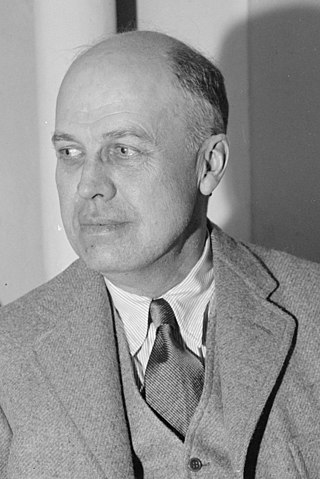
Edward Hopper was an American realist painter and printmaker. He is one of America's most renowned artists and known for his skill in capturing American life and landscapes through his art.
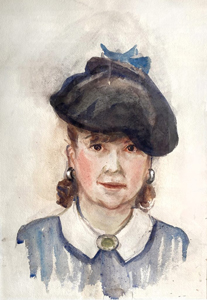
Josephine "Jo" Verstille Hopper was an American painter who studied under Robert Henri and Kenneth Hayes Miller, and won the Huntington Hartford Foundation fellowship.

Nighthawks is a 1942 oil-on-canvas painting by the American artist Edward Hopper that portrays four people in a downtown diner late at night as viewed through the diner's large glass window. The light coming from the diner illuminates a darkened and deserted urban streetscape.

Chop Suey (1929) is an oil painting on canvas by the American artist Edward Hopper. The foreground of the work portrays two women in conversation at a restaurant. In November 2018, it was sold at $92 million, a record price for the artist's work.

Automat is a 1927 oil painting by the American realist painter Edward Hopper. The painting was first displayed on Valentine's Day 1927 at the opening of Hopper's second solo show, at the Rehn Galleries in New York City. By April it had been sold for $1,200. The painting is today owned by the Des Moines Art Center, in Iowa.
John Wesley Hardrick was an American artist. He painted landscapes, still lifes and portraits.
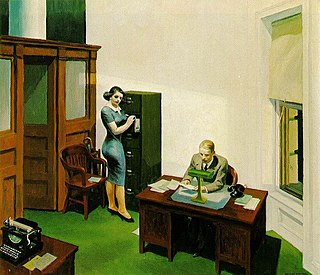
Office at Night is a 1940 oil-on-canvas painting by the American realist painter Edward Hopper. It is owned by the Walker Art Center in Minneapolis, Minnesota, which purchased it in 1948.
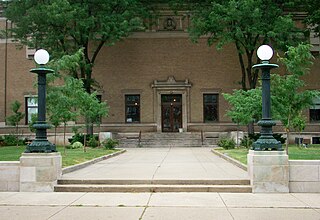
The Sewall Memorial Torches are a pair of bronze lampposts built in 1923 in honor of May Wright Sewall, an educator, civic organizer, women's rights activist, and peace movement advocate, who was a founder of the Art Association of Indianapolis in 1883.

Two Figures is a bronze sculpture by the English sculptor Barbara Hepworth, which was cast in an edition of seven copies. One of these is located at Newfields, the campus that also houses the Indianapolis Museum of Art in Indianapolis, Indiana. Other casts are at Southampton University, the Fred Jones Jr. Museum of Art at the University of Oklahoma, Commonwealth Park in Canberra Australia, and the Hakone Open-Air Museum, Hakone, Japan. The series were cast at the Morris Singer Foundry in London from 1968 onwards. Another cast of this work could also be found at the University of Birmingham Vale site, but is no longer present as of January 2, 2012.

Stumbling Man is an outdoor sculpture by American artist David K. Rubins (1902–1985) located on the grounds of the Indianapolis Museum of Art (IMA), which is near downtown Indianapolis, Indiana. The sculpture is cast bronze and is in the shape of a man crouched upon the ground.

Early Sunday Morning is a 1930 oil painting by American artist Edward Hopper.

The Boat Builders is an oil painting on panel executed in 1873 by American landscape painter Winslow Homer. It is held in the collection of the Indianapolis Museum of Art (IMA), in Indianapolis, Indiana, United States.

The Three Graces is a nearly life-size, figurative Carrara marble outdoor sculpture group located on the historic Oldfields estate on the campus of the Indianapolis Museum of Art (IMA), in Indianapolis, Indiana. The neoclassical marble sculpture depicts the Three Graces, minor goddesses of the Greco-Roman pantheon. The group consists of three women frontally oriented, standing in a row upon a base. The sculpture is modeled after a c. 1797 sculpture by Antonio Canova.

Red Kimono on the Roof is an oil painting by American artist John Sloan, located in the Indianapolis Museum of Art, which is in Indianapolis, Indiana, USA. Painted in 1912, its down-to-earth subject matter and execution make it an excellent example of the work of the Ashcan School, which was active in New York City in the early years of the twentieth century.
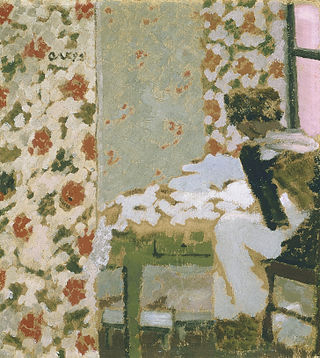
The Seamstress is an 1893 oil painting by French artist Édouard Vuillard, located in the Indianapolis Museum of Art, which is in Indianapolis, Indiana. It is a small, intimate image of a woman sewing.
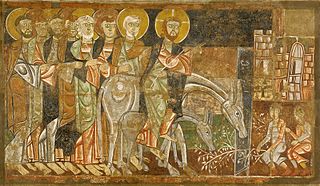
Entry of Christ into Jerusalem is an 1125 fresco by the Master of San Baudelio de Berlanga, originally located at San Baudelio de Berlanga but now on display in the Indianapolis Museum of Art, which is in Indianapolis, Indiana. It depicts Christ and seven disciples entering Jerusalem to the acclaim of its inhabitants.
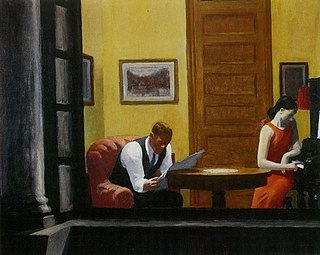
Room in New York is a 1932 oil-on-canvas painting by the American artist Edward Hopper that portrays two individuals in a New York City flat. It is held in the collection of the Sheldon Museum of Art. The painting is said to have been inspired by the glimpses of lighted interiors seen by the artist near the district where he lived in Washington Square.

New York Movie is an oil on canvas painting by American painter Edward Hopper. The painting was begun in December 1938 and finished in January of 1939. Measuring 32 1/4 x 40 1/8", New York Movie depicts a nearly empty movie theater occupied with a few scattered moviegoers and a pensive usherette lost in her thoughts. Praised for its brilliant portrayal of multiple light sources, New York Movie is one of Hopper's well-regarded works.

Ground Swell is a 1939 painting by American artist Edward Hopper which depicts five people on a heeling catboat in a light swell, looking at an ominous buoy. It was in the collection of the Corcoran Gallery of Art from 1943 until it was purchased by the National Gallery of Art in Washington, D.C. in 2014.
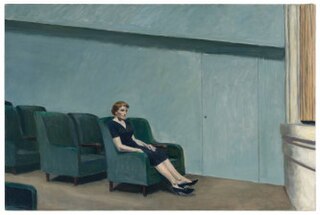
Intermission is a 1963 painting by American realist Edward Hopper (1882–1967). It is a late period painting completed between March and April at his New York home and studio in Washington Square Park, in the Greenwich Village neighborhood of Lower Manhattan, New York City, four years before his death at age 84. The work depicts a woman in a theater wearing a blue and black dress and black shoes, sitting by herself in a green aisle seat near a blue wall. It is one of the largest paintings ever completed by Hopper, and is his penultimate theater-themed work, followed by Two Comedians (1966), his last painting. It was acquired by the San Francisco Museum of Modern Art in 2012.



















